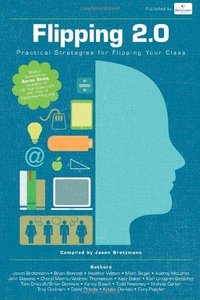Flipping 2.0Practical Strategies for Flipping Your Class
|

|
 Diese Seite wurde seit 1 Jahr inhaltlich nicht mehr aktualisiert.
Unter Umständen ist sie nicht mehr aktuell.
Diese Seite wurde seit 1 Jahr inhaltlich nicht mehr aktualisiert.
Unter Umständen ist sie nicht mehr aktuell.
 Zusammenfassungen
Zusammenfassungen
 If you've decided to flip your class, you probably have new questions: How do I do this? What will it look like? What will students do in class? How will I create learning experiences for students outside of class? What have other teachers done?
Flipping 2.0:Practical Strategies for Flipping Your Class seeks to answer your questions. And it opens the dialogue for us to continue to learn together.
In this book, you will follow practicing classroom teachers as they walk you through their flipped classroom journey; why and how they made the change, what obstacles they overcame, the technology they used, and where they are heading next. As a flipped learning teacher, you need time to check out workable solutions that other teachers have created.
Look inside their classrooms and learn from their experiences. Watch flipped teachers at work. Pick the brains of those who've been there, and join the conversation.
You'll find something useful in every chapter. And there is a chapter just for you in this book.
With a chapter on mastery learning by Brian Bennett, two chapters on English by Cheryl Morris/Andrew Thomasson and Kate Baker, two chapters on social studies by Jason Bretzmann and Karl Lindgren-Streicher, two chapters on math by Audrey McLaren and John Stevens, two chapters on science by Marc Seigel and David Prindle, Google tools for flipping by Troy Cockrum, two chapters on technology by Cory Peppler and Tom Driscoll/Brian Germain, part-time flipping by Kenny Bosch, elementary school flipping by Todd Nesloney, middle school flipping by Nichole Carter, world languages flipping by Heather Witten, co-flipping by Cheryl Morris/Andrew Thomasson and even flipping your professional development by Kristin Daniels.
If you've decided to flip your class, you probably have new questions: How do I do this? What will it look like? What will students do in class? How will I create learning experiences for students outside of class? What have other teachers done?
Flipping 2.0:Practical Strategies for Flipping Your Class seeks to answer your questions. And it opens the dialogue for us to continue to learn together.
In this book, you will follow practicing classroom teachers as they walk you through their flipped classroom journey; why and how they made the change, what obstacles they overcame, the technology they used, and where they are heading next. As a flipped learning teacher, you need time to check out workable solutions that other teachers have created.
Look inside their classrooms and learn from their experiences. Watch flipped teachers at work. Pick the brains of those who've been there, and join the conversation.
You'll find something useful in every chapter. And there is a chapter just for you in this book.
With a chapter on mastery learning by Brian Bennett, two chapters on English by Cheryl Morris/Andrew Thomasson and Kate Baker, two chapters on social studies by Jason Bretzmann and Karl Lindgren-Streicher, two chapters on math by Audrey McLaren and John Stevens, two chapters on science by Marc Seigel and David Prindle, Google tools for flipping by Troy Cockrum, two chapters on technology by Cory Peppler and Tom Driscoll/Brian Germain, part-time flipping by Kenny Bosch, elementary school flipping by Todd Nesloney, middle school flipping by Nichole Carter, world languages flipping by Heather Witten, co-flipping by Cheryl Morris/Andrew Thomasson and even flipping your professional development by Kristin Daniels. Dieses Buch erwähnt ...
Dieses Buch erwähnt ...
 Dieses Buch erwähnt vermutlich nicht ...
Dieses Buch erwähnt vermutlich nicht ... 
 Nicht erwähnte Begriffe | Bildung, Digitalisierung, Kinder, Schweiz, Unterricht |
 Tagcloud
Tagcloud
 Volltext dieses Dokuments
Volltext dieses Dokuments
 Bibliographisches
Bibliographisches 
 Beat und dieses Buch
Beat und dieses Buch
Beat hat dieses Buch während seiner Zeit am Institut für Medien und Schule (IMS) ins Biblionetz aufgenommen. Beat besitzt kein physisches, aber ein digitales Exemplar. (das er aber aus Urheberrechtsgründen nicht einfach weitergeben darf). Es gibt bisher nur wenige Objekte im Biblionetz, die dieses Werk zitieren.











 Edmodo
Edmodo Google
Google instant gratification
instant gratification LehrerIn
LehrerIn Lernen
Lernen Schule
Schule

 Biblionetz-History
Biblionetz-History